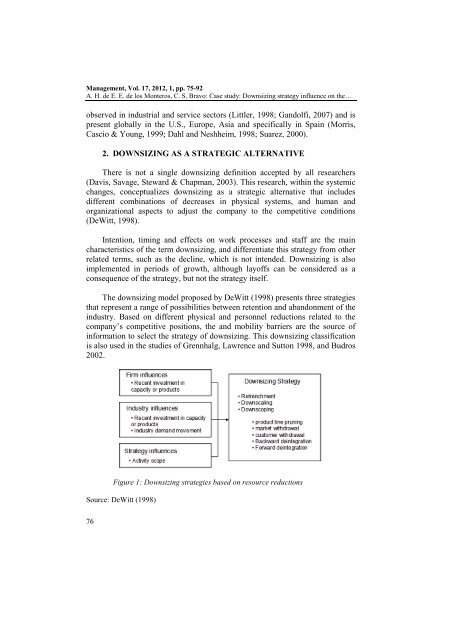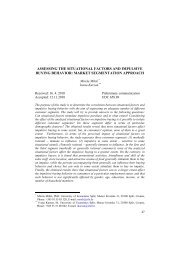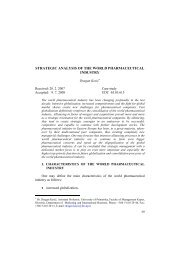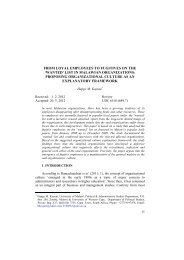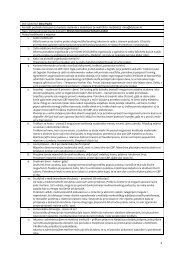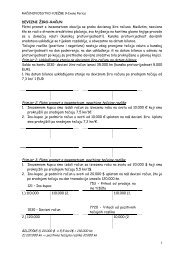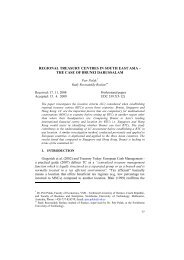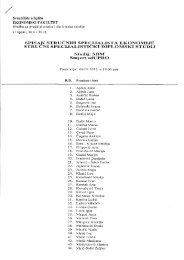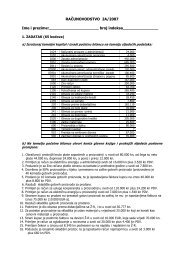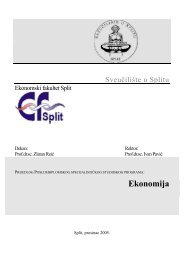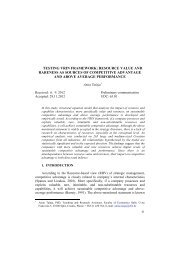Case study: Downsizing strategy influence on the structure of the firm
Case study: Downsizing strategy influence on the structure of the firm
Case study: Downsizing strategy influence on the structure of the firm
Create successful ePaper yourself
Turn your PDF publications into a flip-book with our unique Google optimized e-Paper software.
Management, Vol. 17, 2012, 1, pp. 75-92<br />
A. H. de E. E. de los M<strong>on</strong>teros, C. S. Bravo: <str<strong>on</strong>g>Case</str<strong>on</strong>g> <str<strong>on</strong>g>study</str<strong>on</strong>g>: <str<strong>on</strong>g>Downsizing</str<strong>on</strong>g> <str<strong>on</strong>g>strategy</str<strong>on</strong>g> <str<strong>on</strong>g>influence</str<strong>on</strong>g> <strong>on</strong> <strong>the</strong>…<br />
observed in industrial and service sectors (Littler, 1998; Gandolfi, 2007) and is<br />
present globally in <strong>the</strong> U.S., Europe, Asia and specifically in Spain (Morris,<br />
Cascio & Young, 1999; Dahl and Neshheim, 1998; Suarez, 2000).<br />
2. DOWNSIZING AS A STRATEGIC ALTERNATIVE<br />
There is not a single downsizing definiti<strong>on</strong> accepted by all researchers<br />
(Davis, Savage, Steward & Chapman, 2003). This research, within <strong>the</strong> systemic<br />
changes, c<strong>on</strong>ceptualizes downsizing as a strategic alternative that includes<br />
different combinati<strong>on</strong>s <strong>of</strong> decreases in physical systems, and human and<br />
organizati<strong>on</strong>al aspects to adjust <strong>the</strong> company to <strong>the</strong> competitive c<strong>on</strong>diti<strong>on</strong>s<br />
(DeWitt, 1998).<br />
Intenti<strong>on</strong>, timing and effects <strong>on</strong> work processes and staff are <strong>the</strong> main<br />
characteristics <strong>of</strong> <strong>the</strong> term downsizing, and differentiate this <str<strong>on</strong>g>strategy</str<strong>on</strong>g> from o<strong>the</strong>r<br />
related terms, such as <strong>the</strong> decline, which is not intended. <str<strong>on</strong>g>Downsizing</str<strong>on</strong>g> is also<br />
implemented in periods <strong>of</strong> growth, although lay<strong>of</strong>fs can be c<strong>on</strong>sidered as a<br />
c<strong>on</strong>sequence <strong>of</strong> <strong>the</strong> <str<strong>on</strong>g>strategy</str<strong>on</strong>g>, but not <strong>the</strong> <str<strong>on</strong>g>strategy</str<strong>on</strong>g> itself.<br />
The downsizing model proposed by DeWitt (1998) presents three strategies<br />
that represent a range <strong>of</strong> possibilities between retenti<strong>on</strong> and aband<strong>on</strong>ment <strong>of</strong> <strong>the</strong><br />
industry. Based <strong>on</strong> different physical and pers<strong>on</strong>nel reducti<strong>on</strong>s related to <strong>the</strong><br />
company’s competitive positi<strong>on</strong>s, <strong>the</strong> and mobility barriers are <strong>the</strong> source <strong>of</strong><br />
informati<strong>on</strong> to select <strong>the</strong> <str<strong>on</strong>g>strategy</str<strong>on</strong>g> <strong>of</strong> downsizing. This downsizing classificati<strong>on</strong><br />
is also used in <strong>the</strong> studies <strong>of</strong> Grennhalg, Lawrence and Sutt<strong>on</strong> 1998, and Budros<br />
2002.<br />
Figure 1: <str<strong>on</strong>g>Downsizing</str<strong>on</strong>g> strategies based <strong>on</strong> resource reducti<strong>on</strong>s<br />
Source: DeWitt (1998)<br />
76


